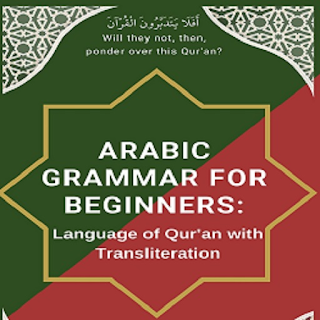3.4 A/B/C - Property 2 - Noun Capacity/ Definite Nouns/ Definite by Pronoun/ Personal Pronoun
Section 3.4 - Property 2 Capacity وُسْعَتٌ (wus-'at)
The capacity of a Noun is divided into two categories. These are Definite مَعْرِفَةُ (ma-aa-ri-fa-tu) and Indefinite نَكِرَةٌ (na-ki-ra-tun) Nouns. All Nouns are considered indefinite until proven to be definite Nouns. The categories of definite Nouns are described below.
A. Definite Nouns مَعْرِفَةُ (ma'-ri-fa-tu)
A definite Noun, according to Webster’s dictionary, is an article that is:
free of all ambiguity, uncertainty, or obscurity, unquestionable, decided
typically designating an identified or immediately identifiable person or thing.
In Arabic, the following are classified as definite Nouns:
-A Name or a proper Noun
-A personal pronoun
-A demonstrative pronoun
-A relative pronoun
-When alphabets (ا) and (ل) are added in front
-When an indefinite Noun is associated with a definite Noun, it becomes a definite Noun.
-When an indefinite Noun is used in addressing/calling a definite Noun, it also becomes a definite Noun.
B. Definite by Proper Noun/ Name اِسْمُ الْعَلَمِ (Ism-ul 'ala-mi)
All names are definite Nouns. For example, زَيْدٌ (Zai-dun or in spoken Arabic, this will be pronounced as Zaid) which is a name of a male person or مَكَّةُ (mak-katu or Makkah in spoken Arabic) is the name of a city.
C. Definite by Personal pronoun ضَمِيْرٌ dhameer-un
All pronouns are definite Nouns. These are called اَلضَّمَائَرُ (adh-dha-mai-ru),which is a plural of ضَمِيْرٌ (dhamee-run), which is singular.
Definition of a pronoun
A small set of words in a language are used as substitutes for Nouns or Noun phrases and whose referents are named or understood in that context.
Unlike the English language, in Arabic, the pronouns are defined individually depending upon who is referred to as gender (male, female) and their number (single, dual, plural). For a single, like English, one word is used for male هُوَ for he and one for female هِىَ for she. There is no equivalent for "it" in Arabic. Everything has a gender, even numbers. For dual and plural, it is a different story. There are separate pronouns for dual and plural, even for males and females. Thus, we should get four pronouns for single, dual, male, and female. But for dual, male and female are the same (an exception), so ultimately, we get three. For example, one word “they” is used for both two or more absent males and females in English. In Arabic, these would be هُمَا (hu-ma) for two absent males and هُمْ (hum) for more than two absent males, هُمَا (hu-ma) for two absent females, and هُنَّ (hun-na) for more than two absent females. The same thing happens even for 2nd person, so أَنْتُمَا is used for both dual male and female.
Also, in Arabic, prepositions can be detached or attached. Detached pronouns are used by themselves, while attached pronouns are joined with Nouns to form a compound.
1) Detached pronouns are always in Nominative رَفْعٌ (raf-un) state. Examples of detached are هُوَ (hua) meaning he, اَنْتَ (an-ta) meaning you, and اَنَا (an-aa) meaning me. Also, these pronouns are always inflexible (مَبْنِي) mab-ni, which means they have only one state and form.
2) Attached pronouns are always in Accusative نَصْبٌ (nas-bun) or Genitive جَرٌّ (jarr-un) state. Examples would be كَ for you and ي for me as in كِتَابُكَ (kitaa-bu-ka) meaning your book and كِتَابِيْ (ki-taa-bi) meaning my book. These are described in Table 3 for attached and Table 4 for detached pronouns below after the column version.
Also, these pronouns are also always inflexible (مَبْنِي) mab-ni, which means they have only one state and form.
It is preferred that you remember and memorize the format in the sequence given below (or any other sequence you may have picked up and be consistent with) since this is commonly used for other Nouns and Verbs attributes. This sequence will be used many times later.
Here is the order to remember in a column form for detached pronouns:
Detached pronouns
| هُوَ | hua | (He)
|
| هُمَا | Hu-maa | (Those two males) |
| هُمْ | hum | (They all males) |
| هِيَ | Hee-yaa | (she) |
| هُمَا | Hu-maa | (Those two females) |
| هُنَّ | Hun-na | (They all females) |
| أَنْتَ | An-ta | (You male) |
| أَنْتُمَا | An-tu-maa | (You two males) |
| أَنْتُمْ | An-tum | (You all females) |
| أَنْتِ | An-ti | (You female) |
| أَنْتُمَا | An-tuma | (you two females) |
| أَنْتُنَّ | An-tun-na | (You all females) |
| اَنَا | An-aa | (I, single male and female) |
| نَحْنُ | Nah-nu | (we, dual, plural, male, female) |
Tables 3 and 4 below show detached and attached pronouns. In the tables below, these should be memorized starting from the left of the first row (hua, hu-ma, hum) and continuing to the second row, again from the left (hiya, huma, hun-na). Next, the third row (anta, an-tuma, an-tum). Then next row (an-ti, antu-maa, an-tunna) and finally the last row (a-naa, nah-nu). The detached pronouns are repeated in a table form for completeness.
Note that نَحنُ (nah-nu) is used for both dual and plural for 1st person.
Table 3 - Detached pronouns الضَّمِيْرُ الْمُنْفَصِلُ adh-dhameerul mun-fa-si-lu
(رَفْعٌ Raf-un) state
|
|
| Single | Dual | Plural |
| 3rd person (absent) | Masculine | هٌوَ
(hua)
he, him | هُمَا
(hu-ma)
those two - males | هٌم
(hum)
they, them - males |
| Feminine | هِيَ
(hee-ya)
she, her | هُمَا
(hu-ma)
those two - females | هُنَّ
(hun-na)
they, them - females | |
| 2nd person (present) | Masculine | اَنْتَ
(anta)
You - male | اَنْتُمَا
(antu-ma)
You two - males | اَنْتُمْ
(an-tum)
you - males |
| Feminine | اَنْتِ
(anti)
You - female | اَنْتُمَا
(antu-ma)
you two - females | اَنْتُنَّ
(an-tun-na)
You - female | |
| 1st person (Speaker) | Masculine | اَنَا (ana-aa)
I, me – male and female | نَحْنُ
(nah-nu)
we, us – males and females | نَحْنُ
(nah-nu)
we, us - males and females |
An example of a detached preposition would be هُوَ زَيْدٌ hua Zaid-dun, meaning he is Zaid. هُوَ hua here is detached.
Table 4 - Attached pronouns الضَّمِيْرُ الْمُتَّصِلُ adh-dhameerul mut-ta-si-lu
( نَصْبٌ/جَرٌّ nas-bun/jarr-un) state
|
|
|
Single
| Dual | Plural |
| 3rd person (absent) | Masculine | هُ
(hu)
he, him | هُمَا
(humaa)
those two males | هٌم
(hum)
they, them - males |
| Feminine | هَا
(haa)
she, her | هُمَا (humaa)
those two females | هُنَّ
(hun-na)
they, them - females | |
| 2nd person (present) | Masculine | كَ
(ka)
You male | كُمَا
(kumaa)
You two males | كُمْ
(kum)
you - males |
| Feminine | كِ
(key)
You female | كُمَا (kumaa)
you two females | كُنَّ
(kun-na)
You (all) females | |
| 1st person (speaker) | Masculine | ىَ
(ya)
I, me | نَا
(naa)
we, us – males and females | نَا
(naa)
we, us - males and females |
| Feminine |
An example of an attached pronoun would be اِسْمُكَ meaning “your name” which is made with Noun (اِسْمٌ) and pronoun (كَ,) which is the attached form of أنْتَ. That is,
اِسْمٌ + كَ = اِسْمُكَ
Sentence and compound word construction will be explained later to show why the tanween ٌwas changed to a dammah ( ُُ ) on the alphabet (م) since اِسْمُكَ is a possessive compound in which the first word always has its e’raab lightened and second word goes into the genitive state (جَرٌّ).
***





Comments